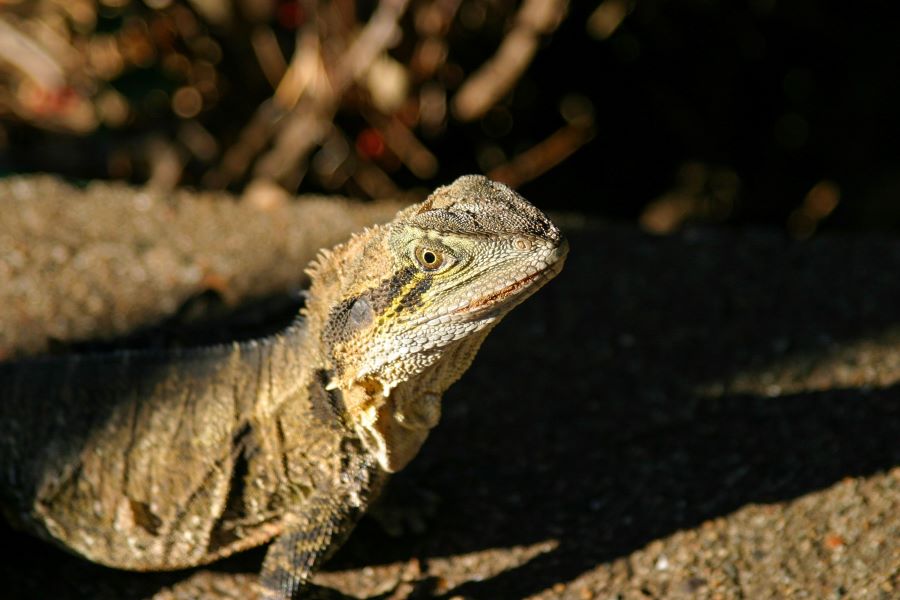Some of the posts on Mercury Pets contain affiliate links to products. That means if you click on that link and then make a purchase, we receive a percentage of the sale. We only recommend products we’ve used and support, and there’s no additional cost to you — the money goes right back into making this site the best it can be! Thanks for reading.

Probably the number one question that any potential skink owner has when thinking about getting a new pet is, are they dangerous? Some skinks are brightly colored, so people think they may be poisonous. Or they see they have lots of small, sharp teeth. But what are the risks in reality?
Skinks are not dangerous and are generally low-risk pets. They are not poisonous or toxic to humans. The worst thing that may happen is they occasionally bite, but there are simple guidelines you can follow to prevent this from ever happening.
If you treat skinks with respect and follow some simple procedures, you should have nothing to worry about. Skinks can make a great family pet and are easily and safely enjoyed by children also. However, it is better to know what you are doing before you start.
- Carefully formulated by nutritionists to be a balanced diet to meet the nutritional needs of Blue tongue skinks for proper growth and development.
- Contains Chopped grasses (timothy, alfalfa) to provide long-stem fiber, An important part of their natural diet.
- Contains small amounts of fruit (mango) and animal protein (Black Soldier fly Larvae) to meet there unique dietary requirements.
- Contains flavorful dandelion greens, Yucca and other plants that Blue tongue skinks love.
- Can be mixed with zoo menu canned Blue tongue skink and Tegu Food and zoo Meds can O’ insect line to add variety to their diet.
Are Skinks Dangerous?
There are very few risks attached to skinks. They have no claws, powerful limbs, or any other weapons to fear. Their only weapon in adversity is their bite, but this is used only as a last resort.
In the wild, skinks react to threats in several ways. They will often flee or hide. Sometimes, if this is not an option, they will stand their ground and open their mouth wide. They will hiss or flick out their tongue (depending on the species). Needless to say, if you see any of these signs in your skink, then give it some space.
Size of Skink Breeds
Different breeds of skink range in size. Clearly, the larger skinks could potentially do a little more harm than the small ones, so this is something to bear in mind.
Smaller skinks are often around 3 inches long. A bite from one of these is no more than a nip.
Larger breeds can reach between 12 and 14 inches long. A bite from a bigger skink can do a bit more damage and could break the skin.
However, bites are uncommon and quite easily avoidable using some simple strategies that we will come on to shortly.
Are Skinks Poisonous?
For some reason, there appear to be quite a few rumors, even superstitions in some parts of the world, that skinks are poisonous.
No skink breeds are poisonous. They are not venomous, and their bite carries no venom.
Some people may be concerned that they look brightly colored like many other poisonous animals, such as frogs or snakes. Despite appearances, the answer to “are skinks poisonous?” is a resounding “NO.”
Do Skinks Bite?
Any lizard has the potential to bite, and skinks are just the same in this regard. However, their bites are unusual and rarely come out of the blue. If you are bitten, you will almost certainly have done something to provoke this, and normally there are signs that it will happen before the event.
Usually, a skink will only bite you for one of the following reasons:
- They are being handled when they do not want to be. Sometimes they can be over-handled, which can stress them out slightly. Be careful not to over-handle any lizard.
- Sometimes they bite because someone has put their fingers in front of their mouth. This is not a malicious bite but just a mistake.
- They are hungry. To avoid this, feed your skink at regular intervals.
- They are nervous or stressed. If they feel threatened by you or see you as a predator for some reason, they may bite. They will normally give plenty of warning for this.
A Few General Biting Guidelines
There are a few little nuggets of information that it is worth knowing. These include:
- Males are more likely to bite than females. This could be something you want to think about when buying one.
- Some breeds are more aggressive than others. An example of a more aggressive one is Tanimbar Island Blue-Tongued Skink. This breed is not recommended for families or if any children will ever come into contact with the skink.

Signs Of Aggression
It would be very rare that a skink would bite completely out of the blue. Almost always, there will be at least one, or often several, signals that it is important to look out for. Some of these signals are quite obvious and are signs that many types of animals make when they are feeling threatened.
Some of the most common signs of possible aggression in a skink include:
- Hissing – This is the most well-known sign to watch for in most lizards. If they start doing this, then back off!
- Flattening their body – This is probably a way of making themselves appear longer and more threatening.
- Puffing themselves up – This is another common strategy used by many animals. Making themselves look bigger is a great decoy to deter predators.
- Open their mouth wide in your direction – This is quite threatening when you see it. It is often done in conjunction with hissing or one of the other signs.
- Flick out their tongue – This is only the case with some breeds, such as the Blue-Tongued Skink. If you see them flicking their tongue in your direction, then leave them alone to calm down.
How To Avoid Getting Bitten
Some simple common sense will normally be enough to stop you from getting bitten by a skink.
The most important way is just to look out for any of the signs above. If you see any, then leave the skink alone to calm down.
Try to handle your skink after they have eaten and when they seem relaxed.
If you are very fearful that your skink may bite you, then you could consider investing in a good pair of gloves. Many iguana owners wear falconry gloves, but also just good-quality gardening gloves will probably do the job fine with the smaller skink.
- WATERPROOF MATERIAL – This Waterproof Animal Handling Gloves Has High Quality upgraded Cowhide has a strong waterproof performance. 2-layer Cowhide at the palm and finger joints give your hands and forearms maximum protection. Especially suitable for bathing pets.
- Flexible Design – Reinforced wing thumb design for maximum flexibility. Easy to handle and hold objects. Durable stitching can ensure your safety and durability of water-resistant.
- Extra Length – Length: 23.6 inch, Palm width: 4.5 inch, suitable for ladies. The long length of the gloves are possible to protect your whole arm from potential hurts, the cover places are wider compared with normal gloves.
- USED By: Veterinarians, Animal Control Staff, Groomers, Kennel Workers, Zoo Workers, Pet Shop Employees, Breeders/Handlers, Pet owners, Bird handlers, Reptile handlers.
- Multifunctional – The waterproof animal handing gloves not only good for bathing, training your lovely pet, enjoying the playing time, but also for home use, useful and essential for your family.
When Getting A New Skink
A new skink will take time to acclimatize to their new surroundings. Often your pet may show several of the signs of aggression over the first few days or weeks.
However, generally, most skinks will start to relax into their new habitat and show much less of these signs. It is sensible to be a bit more cautious of your skink in the early days. It can be a stressful time for any animal.
Avoid much handling, and don’t take any signs of aggression personally! They are just working out what is happening and that you are not a predator that wants to eat them.
Give the skink the love, respect and care that it deserves, and they will start to see you more as an ally than an enemy.
Skink Teeth
Skinks have pleurodont teeth. This basically means that they are fused to the jaw-bone. They have approximately 40 small sharp teeth.
They use these teeth to rip their food, which includes things such as insects and plants.
Please don’t worry too much about their teeth, however! If you treat your skink right, then they are never going to be used on you.
Top Tips To Sum Up
- Skinks are generally not dangerous
- They are neither poisonous nor venomous
- When under threat, most skinks will retreat or hide
- Possible signs of aggression are hissing, opening their mouths wide and poking out their tongue
- If you spot any signs of aggression then give the skink space
- They have tiny teeth that they use to rip their food
- Do not put your fingers in front of their mouth
- If bitten, let the skink release its bite without pulling it off





